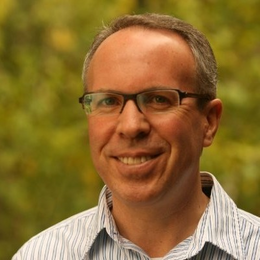How These Med Schools Are Improving End-of-Life Instruction
It's a shift toward care based on who the patient is and what he or she wants
(Editor’s note: This story is part of a special report for The John A. Hartford Foundation.)

While all medical students must witness a birth, being present for someone who’s dying is not a requirement. Dying has traditionally received little attention in medical school curricula. Interviewed by The Boston Herald earlier this year, Dr. Atul Gawande, surgeon, founder of the Massachusetts Coalition for Serious Illness Care and author of Being Mortal (also a Next Avenue Influencer in Aging) said his end-of-life training amounted to one hour of discussion during his first two years in medical school. He’s now part of an innovative effort to improve education about end-of-life care at Massachusetts’ four medical schools: Harvard University, Boston University, Tufts University and the University of Massachusetts Medical School.
What Matters Most at End-of-Life
“We’ve been wrong about what our job is in medicine,” Gawande writes in Being Mortal. “We think our job is to ensure health and survival, but really it is larger than that. It is to enable well-being.” Gawande emphasizes training students to discern what gives a person’s life meaning and then choosing a course of treatment based on what that information involves. It’s a shift away from a “fix-it” mentality, which focuses on prolonging life.
Gawande credits the transformation in his thinking to observing palliative care clinicians and geriatricians. On an episode of PBS' FRONTLINE, Gawande explained that seeing his colleagues’ conversations with their patients taught him what he could do better for his own.
One of those colleagues, Dr. Jennifer Reidy, is chief of palliative care at UMass Memorial Medical Center in Worcester, Mass. and a University of Massachusetts Medical School professor. “What’s great about palliative care is that you can incorporate it into your practice no matter what specialty you are,” Reidy says.
Holding conversations about what matters most and “being able to treat people’s pain and other distressing symptoms that affect their quality of life are all things that any doctor should be able to do in their field,” she says. Reidy foresees eventual changes in training extended to entire care teams: nurses, nurse practitioners, social workers, chaplains and pharmacists.
Reidy was one of the first students to do a palliative care rotation during her training at University of Vermont’s Larner College of Medicine in the late 1990s. There she learned that the care plan should be driven by who the person is, not by the available technology or what was possible.
If a person is diagnosed with an incurable disease, she says, the essential question comes down to: How do you make the most meaningful use of whatever time remains?
According to Reidy, this often means “focusing on being with the people who they love, and being more in their ‘real lives,’” rather than in the hospital. Given the option to forego harsh, life-prolonging therapy, many take care of things left undone such as making amends or getting financial affairs in order.
“It’s so unique to whatever is meaningful for that person,” Reidy says.
Fired Up Students
While details of the curricula will look different, Reidy says students at each participating school will be taught complex communication procedures for breaking difficult news and having conversations about prognoses and end-of-life planning.
When it comes to communication, “no one gets a pass anymore,” says Reidy. What’s exciting to her is that students are fired up about these developments. “It really taps into their sense of meaning and purpose, and why they came into medicine in the first place,” she says.
Students are learning how to share information in chunks and in clear language, then to pause, listen, allow questions, allow silence, allow emotion and sit with someone’s sadness or anger.
“Then they’ll be able to figure out amidst all of this, what’s most important, what should we be focusing on,” Reidy says.
To ascertain what will bring well-being, Gawande promotes students learning to ask:
• What is your understanding of your illness?
• What are your fears and worries for the future?
• What are your priorities if time becomes short?
• What are you willing to sacrifice and what are you not willing to sacrifice?
• What does a good day look like?
Instead of prompting a conversation about death or dying, these questions get to the crux of: How do you live a good life all the way to the very end, with whatever comes?
Building Momentum
Tiffany Chen, a fourth-year University of Massachusetts Medical School student, is a “champion” of the project, says Reidy. Growing up in a multigenerational home with parents and grandparents, Chen was first exposed to palliative care during her senior year of college when her grandfather was diagnosed with Lewy body dementia at the end of his life. Two years later, when her grandmother was diagnosed with bladder cancer, Reidy was assigned to be her palliative care doctor. Chen credits Reidy’s care with changing her grandmother’s course of treatment and the “quality of her death.”
Combined with a love of helping people, that experience inspired Chen to pursue a medical career. She hopes to go into family medicine and eventually have a fellowship that’s integrated in geriatrics and palliative care.
Chen has taken leadership at her school, including being part of organizing a focus group of students interested in giving palliative care “more of a voice.” The new curriculum, she says, promises to make students “better equipped at baseline to have these conversations.” They’ll become more adept at reading people’s cues and better communicators overall, “by first listening,” she says.
“The biggest thing is actually practicing with someone who’s experienced observing, and then giving you feedback,” Chen says. At her school, a simulation lab and new training methods, including role-playing patient actors, are key.
Reidy feels hopeful that the consortium is part of a larger movement, noting that medical schools at the University of Rochester and Yale University have stepped up as leaders.
Massachusetts offers a new model — the first time each of a state’s medical schools have joined forces. It’s this collaborative element that is having an impact on her school’s administration, says Chen. “Prior to this, you’d talk about palliative care being very important and needing to be in the curriculum, but that’s true of a lot of things.” The partnership has created momentum.


The John A. Hartford Foundation is a private, nonpartisan, national philanthropy dedicated to improving the care of older adults. The leader in the field of aging and health, the Foundation has three priority areas: creating age-friendly health systems, supporting family caregivers, and improving serious illness and end-of-life care.

